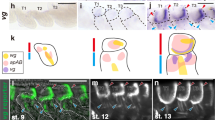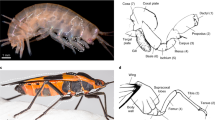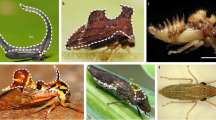Abstract
The origin of insect wings is a biological mystery that has fascinated scientists for centuries. Identification of tissues homologous to insect wings from lineages outside of Insecta will provide pivotal information to resolve this conundrum. Here, through expression and clustered regularly interspaced short palindromic repeats (CRISPR)–CRISPR-associated protein 9 (Cas9) functional analyses in Parhyale, we show that a gene network similar to the insect wing gene network (preWGN) operates both in the crustacean terga and in the proximal leg segments, suggesting that the evolution of a preWGN precedes the emergence of insect wings, and that from an evo-devo perspective, both of these tissues qualify as potential crustacean wing homologues. Combining these results with recent wing origin studies in insects, we discuss the possibility that both tissues are crustacean wing homologues, which supports a dual evolutionary origin of insect wings (that is, novelty through a merger of two distinct tissues). These outcomes have a crucial impact on the course of the intellectual battle between the two historically competing wing origin hypotheses.
This is a preview of subscription content, access via your institution
Access options
Access Nature and 54 other Nature Portfolio journals
Get Nature+, our best-value online-access subscription
$29.99 / 30 days
cancel any time
Subscribe to this journal
Receive 12 digital issues and online access to articles
$119.00 per year
only $9.92 per issue
Buy this article
- Purchase on Springer Link
- Instant access to full article PDF
Prices may be subject to local taxes which are calculated during checkout





Similar content being viewed by others
References
Clark-Hachtel, C. M. & Tomoyasu, Y. Exploring the origin of insect wings from an evo-devo perspective. Curr. Opin. Insect Sci. 13, 77–85 (2016).
Quartau, J. A. An overview of the paranotal theory on the origin of the insect wings. Publicações do Inst. Zool. ‘Dr. Augusto Nobre’. Fac. Cienc. do Porto 194, 1–42 (1986).
Kukalova-Peck, J. Origin of the insect wing and wing articulation from the arthropodan leg. Can. J. Zool. 61, 1618–1669 (1983).
Tomoyasu, Y., Ohde, T. & Clark-Hachtel, C. M. What serial homologs can tell us about the origin of insect wings. F1000Research 6, 268 (2017).
Alexander, D. E. in On the Wing: Insects, Pterosaurs, Birds, Bats and the Evolution of Animal Flight 74–102 (Oxford Univ. Press, 2015).
Grodnitsky, D. L. Form and Function of Insect Wings: The Evolution of Biological Structures (The Johns Hopkins Univ. Press, 1999).
Hughes, C. L. & Kaufman, T. C. Hox genes and the evolution of the arthropod body plan. Evol. Dev. 4, 459–499 (2002).
Wagner, G. P. Homology, Genes, and Evolutionary Innovation (Princeton Univ. Press, 2014).
Ohde, T., Yaginuma, T. & Niimi, T. Insect morphological diversification through the modification of wing serial homologs. Science 340, 495–498 (2013).
Clark-Hachtel, C. M., Linz, D. M. & Tomoyasu, Y. Insights into insect wing origin provided by functional analysis of vestigial in the red flour beetle, Tribolium castaneum. Proc. Natl Acad. Sci. USA 110, 16951–16956 (2013).
Medved, V. et al. Origin and diversification of wings: insights from a neopteran insect. Proc. Natl Acad. Sci. USA 112, 15946–15951 (2015).
Elias-Neto, M. & Belles, X. Tergal and pleural structures contribute to the formation of ectopic prothoracic wings in cockroaches. R. Soc. Open Sci. 3, 160347 (2016).
Linz, D. M. & Tomoyasu, Y. Dual evolutionary origin of insect wings supported by an investigation of the abdominal wing serial homologs in Tribolium. Proc. Natl Acad. Sci. USA 115, E658–E667 (2018).
Tomoyasu, Y. Evo–devo: the double identity of insect wings. Curr. Biol. 28, R75–R77 (2018).
Clark-Hachtel, C. M., Moe, M. R. & Tomoyasu, Y. Detailed analysis of the prothoracic tissues transforming into wings in the Cephalothorax mutants of the Tribolium beetle. Arthropod Struct. Dev. 47, 352–361 (2018).
Rehm, E. J., Hannibal, R. L., Chaw, R. C., Vargas-Vila, M. A. & Patel, N. H. The crustacean Parhyale hawaiensis: a new model for arthropod development. Cold Spring Harb. Protoc. 4, (2009).
Serano, J. M. et al. Comprehensive analysis of Hox gene expression in the amphipod crustacean Parhyale hawaiensis. Dev. Biol. 409, 297–309 (2016).
Martin, A. et al. CRISPR/Cas9 mutagenesis reveals versatile roles of Hox genes in crustacean limb specification and evolution. Curr. Biol. 26, 14–26 (2016).
Sun, D. A. & Patel, N. H. The amphipod crustacean Parhyale hawaiensis: an emerging comparative model of arthropod development, evolution, and regeneration. Wiley Interdiscip. Rev. Dev. Biol. 8, e355 (2019).
Kao, D. et al. The genome of the crustacean Parhyale hawaiensis, a model for animal development, regeneration, immunity and lignocellulose digestion. eLife 5, e20062 (2016).
Williams, J. A., Bell, J. B. & Carroll, S. B. Control of Drosophila wing and haltere development by the nuclear vestigial gene product. Genes Dev. 5, 2481–2495 (1991).
Halder, G. et al. The Vestigial and Scalloped proteins act together to directly regulate wing-specific gene expression in Drosophila. Genes Dev. 12, 3900–3909 (1998).
Kim, J. et al. Integration of positional signals and regulation of wing formation and identity by Drosophila vestigial gene. Nature 382, 133–138 (1996).
Baena-López, L. A. & García-Bellido, A. Genetic requirements of vestigial in the regulation of Drosophila wing development. Development 130, 197–208 (2003).
Niwa, N. et al. Evolutionary origin of the insect wing via integration of two developmental modules. Evol. Dev. 12, 168–176 (2010).
Averof, M. & Cohen, S. M. Evolutionary origin of insect wings from ancestral gills. Nature 385, 627–630 (1997).
Tomoyasu, Y., Arakane, Y., Kramer, K. J. & Denell, R. E. Repeated co-options of exoskeleton formation during wing-to-elytron evolution in beetles. Curr. Biol. 19, 2057–2065 (2009).
Ng, M., Diaz-Benjumea, F. J. & Cohen, S. M. nubbin encodes a POU-domain protein required for proximal-distal patterning in the Drosophila wing. Development 121, 589–599 (1995).
Cifuentes, F. J. & Garcia-Bellido, A. Proximo-distal specification in the wing disc of Drosophila by the nubbin gene. Proc. Natl Acad. Sci. USA. 94, 11405–11410 (1997).
Turchyn, N., Chesebro, J., Hrycaj, S., Couso, J. P. & Popadić, A. Evolution of nubbin function in hemimetabolous and holometabolous insect appendages. Dev. Biol. 357, 83–95 (2011).
Li, H. & Popadić, A. Analysis of nubbin expression patterns in insects. Evol. Dev. 6, 310–324 (2004).
Prakash, A. & Monteiro, A. apterous A specifies dorsal wing patterns and sexual traits in butterflies. Proc. R. Soc. B 285, 20172685 (2018).
Brook, W. J., Diaz-Benjumea, F. J. & Cohen, S. M. Organizing spatial pattern in limb development. Annu. Rev. Cell Dev. Biol. 12, 161–180 (1996).
Zecca, M. & Struhl, G. Control of Drosophila wing growth by the vestigial quadrant enhancer. Development 134, 3011–3020 (2007).
Browne, W. E., Price, A. L., Gerberding, M. & Patel, N. H. Stages of embryonic development in the amphipod crustacean, Parhyale hawaiensis. Genesis 42, 124–149 (2005).
Peel, A. The evolution of arthropod segmentation mechanisms. BioEssays 26, 1108–1116 (2004).
Patel, N. H. et al. Expression of engrailed proteins in arthropods, annelids, and chordates. Cell 58, 955–968 (1989).
Clark, E., Peel, A. D. & Akam, M. Arthropod segmentation. Development 146, dev170480 (2019).
Grimm, S. & Pflugfelder, G. O. Control of the gene optomotor-blind in Drosophila wing development by decapentaplegic and wingless. Science 271, 1601–1604 (1996).
Cook, O., Biehs, B. & Bier, E. brinker and optomotor-blind act coordinately to initiate development of the L5 wing vein primordium in Drosophila. Development 131, 2113–2124 (2004).
Pflugfelder, G. O., Eichinger, F. & Shen, J. T-box genes in Drosophila limb development. Curr. Top. Dev. Biol. 122, 313–354 (2017).
Kobayashi, Y. Formation of subcoxae-1 and 2 in insect embryos: the subcoxal theory revisited. Proc. Arthropod. Embryol. Soc. Jpn 48, 33–38 (2017).
Mashimo, Y. & Machida, R. Embryological evidence substantiates the subcoxal theory on the origin of pleuron in insects. Sci. Rep. 7, 12597 (2017).
Snodgrass, R. E. in Principles of Insect Morphology 157–192 (Cornell Univ. Press, 1935).
Deuve, T. What is the epipleurite? A contribution to the subcoxal theory as applied to the insect abdomen. Ann. Soc. Entomol. Fr. 54, 1–26 (2018).
Coulcher, J. F., Edgecombe, G. D. & Telford, M. J. Molecular developmental evidence for a subcoxal origin of pleurites in insects and identity of the subcoxa in the gnathal appendages. Sci. Rep. 5, 15757 (2015).
Bruce, H. S. & Patel, N. H. Insect wings and body wall evolved from ancient leg segments. Preprint at bioRxiv https://doi.org/10.1101/244541 (2018).
Kukalova-Peck, J. Phylogeny of higher taxa in Insecta: finding synapomorphies in the extant fauna and separating them from homoplasies. Evol. Biol. 35, 4–51 (2008).
Franch-Marro, X., Martín, N., Averof, M. & Casanova, J. Association of tracheal placodes with leg primordia in Drosophila and implications for the origin of insect tracheal systems. Development 133, 785–790 (2006).
Moczek, A. P. & Rose, D. J. Differential recruitment of limb patterning genes during development and diversification of beetle horns. Proc. Natl Acad. Sci. USA 106, 8992–8997 (2009).
Fisher, C. R., Wegrzyn, J. L. & Jockusch, E. L. Co-option of wing-patterning genes underlies the evolution of the treehopper helmet. Nat. Ecol. Evol. 4, 250–260 (2020).
Shiga, Y. et al. Repeated co-option of a conserved gene regulatory module underpins the evolution of the crustacean carapace, insect wings and other flat outgrowths. Preprint at bioRxiv https://doi.org/10.1101/160010 (2017).
Carroll, S. B. Evo-devo and an expanding evolutionary synthesis: a genetic theory of morphological evolution. Cell 134, 25–36 (2008).
Knoll, A. H. & Carroll, S. B. Early animal evolution: emerging views from comparative biology and geology. Science 284, 2129–2137 (1999).
Prokop, J. et al. Paleozoic nymphal wing pads support dual model of insect wing origins. Curr. Biol. 27, 263–269 (2017).
Requena, D. et al. Origins and specification of the Drosophila wing. Curr. Biol. 27, 3826–3836.e5 (2017).
Wagner, G. P. & Lynch, V. J. Evolutionary novelties. Curr. Biol. 20, R48–R52 (2010).
Monteiro, A. & Podlaha, O. Wings, horns, and butterfly eyespots: how do complex traits evolve? PLoS Biol. 7, e37 (2009).
Kuratani, S., Kuraku, S. & Nagashima, H. Evolutionary developmental perspective for the origin of turtles: the folding theory for the shell based on the developmental nature of the carapacial ridge. Evol. Dev. 13, 1–14 (2011).
Lyson, T. R., Bever, G. S., Scheyer, T. M., Hsiang, A. Y. & Gauthier, J. A. Evolutionary origin of the turtle shell. Curr. Biol. 23, 1113–1119 (2013).
Chuong, C. M., Chodankar, R., Widelitz, R. B. & Jiang, T. X. Evo-devo of feathers and scales: building complex epithelial appendages. Curr. Opin. Genet. Dev. 10, 449–456 (2000).
Widelitz, R. B. et al. Molecular biology of feather morphogenesis: a testable model for evo-devo research. J. Exp. Zool. B 298, 109–122 (2003).
Chen, C.-F. et al. Development, regeneration, and evolution of feathers. Annu. Rev. Anim. Biosci. 3, 169–195 (2015).
Hu, Y., Linz, D. M. & Moczek, A. P. Beetle horns evolved from wing serial homologs. Science 366, 1004–1007 (2019).
Shubin, N., Tabin, C. & Carroll, S. Deep homology and the origins of evolutionary novelty. Nature 457, 818–823 (2009).
Rehm, E. J., Hannibal, R. L., Chaw, R. C., Vargas-Vila, M. A. & Patel, N. H. Fixation and dissection of Parhyale hawaiensis embryos. Cold Spring Harb. Protoc. 4, (2009).
Rehm, E. J., Hannibal, R. L., Chaw, R. C., Vargas-Vila, M. A. & Patel, N. H. In situ hybridization of labeled RNA probes to fixed Parhyale hawaiensis embryos. Cold Spring Harb. Protoc. 4 (2009).
Shippy, T. D., Coleman, C. M., Tomoyasu, Y. & Brown, S. J. Concurrent in situ hybridization and antibody staining in red flour beetle (Tribolium) embryos. Cold Spring Harb. Protoc. 4 (2009).
Bassett, A. & Liu, J.-L. CRISPR/Cas9 mediated genome engineering in Drosophila. Methods 69, 128–136 (2014).
Rehm, E. J., Hannibal, R. L., Chaw, R. C., Vargas-Vila, M. A. & Patel, N. H. Injection of Parhyale hawaiensis blastomeres with fluorescently labeled tracers. Cold Spring Harb. Protoc. 4, (2009).
Gloor, G. & Engels, W. Single-fly DNA preps for PCR. Drosoph. Inf. Newsl. 1, (1991).
Grimaldi, D. & Engels, M. S. Evolution of the Insects (Cambridge Univ. Press, 2005).
Misof, B. et al. Phylogenomics resolves the timing and pattern of insect evolution. Science 346, 763–767 (2014).
Acknowledgements
We thank N. Patel and H. Bruce for technical assistance and sharing their preprint, and X. Franch-Marro for the Ph-vvl clone. We also thank the Center for Bioinformatics and Functional Genomics (CBFG) and the Center for Advanced Microscopy and Imaging (CAMI) at Miami University for technical support, S. Yi for technical assistance and T. Ohde, A. Fernándes, D. Linz, N. Patel, H. Bruce, A. Martin and other members of the Tomoyasu and Patel labs for helpful discussions. This work is supported by the Miami University Faculty Research Grants Program (CFR) (to Y.T.), the National Science Foundation (NSF) (IOS1557936 to Y.T.), an NSF Graduate Research Fellowship (to C.M.C.-H.) and EDEN: Evo-Devo- Eco Network (NSF-IOS0955517 to C.M.C.-H.).
Author information
Authors and Affiliations
Contributions
C.M.C.-H. and Y.T. conceived the experiments. C.M.C.-H. performed the experiments. C.M.C.-H. and Y.T. analysed the data and wrote the manuscript.
Corresponding author
Ethics declarations
Competing interests
The authors declare no competing interests.
Additional information
Publisher’s note Springer Nature remains neutral with regard to jurisdictional claims in published maps and institutional affiliations.
Extended data
Extended Data Fig. 1 Alignments of evolutionarily conserved protein domains.
a, Alignment for the Vg Tondu domain. b, c, POU domain (b) and homeodomain (c) alignments of Nub and Vvl. Both Nub and Vvl belong to the POU-homeodomain protein family; however, each class possesses some characteristic amino acids in the conserved domains (yellow and blue highlighted amino acids). d, Ap homeodomain alignment. Characteristic amino acids found among the two classes of Apterous (A and B) and the corresponding vertebrate homologs are highlighted. The presence of characteristic amino acids for A and B classes indicates that the emergence of these two arthropod Apterous classes preceded the divergence of crustaceans and hexapods. Amino acid sequences for Parhyale proteins were translated from the cloned cDNA sequences. In some cases, additional sequence was added from the published genome assembly (Ph-apA and Ph-apB) or additional cDNA clones (Ph-vvl)49 to obtain the longest conserved domain amino acid sequence possible. Amino acid sequences for other species were obtained from NCBI and OrthoDB except for Af-ApB homeodomain which was obtained from26. Species abbreviations: Af- Artemia franciscana, Am-Apis mellifera, Bg-Blattella germanica, Bm-Bombyx mori, Da-Daphnia magna, Dm- Drosophila melanogaster, Dr- Danio rerio, Mm- Mus musculus, Ph-Parhyale hawaiensis, Of-Oncopeltus fasciatus, Tc-Tribolium castaneum.
Extended Data Fig. 2 Deletions induced by vg and apA CRISPR/Cas9 KO.
a, vg KO2 alignments. b, vg KO3 alignments. c, apA KO2 alignments. d, apA KO3 alignment. The top line in each alignment shows the WT sequence with the targeted site (green) and the Protospacer adjacent motif (PAM) (blue highlight). Red in brackets with “Δ” indicates the number of base pairs deleted from that region and blue in brackets with “+” indicates the number of base pairs added to that region. Yellow nucleotides indicate SNPs.
Extended Data Fig. 3 T7 endonuclease I assay.
a, nub KO1. b, nub KO3. c, apA KO2. d, apA KO3. “M” refers to the sacrificed hatchling that exhibited visible mutant phenotypes, while “WT” with gene prefix indicates CRISPR/Cas9 injected individuals that lacked any visible abnormalities. “WT” with no gene prefix is the negative control, with the corresponding genomic region isolated from un-injected WT hatchlings. “+” and “-” indicate presence and absence of T7 endonuclease I. Asterisks indicate T7 endonuclease I digested bands.
Extended Data Fig. 4 Additional images for nub KO.
Individual with curled tergal phenotype (arrowhead).
Extended Data Fig. 5 Ph-apB expression pattern.
Arrow indicates strong expression of Ph-apB in the brain. Embryo is ~stage 21.
Extended Data Fig. 6 Insect wing gene network.
A simplified version of the wing gene network (WGN) described in Drosophila. The six genes investigated in this study are indicated in red.
Extended Data Fig. 7
Expression pattern for all genes analyzed in this study.
Supplementary information
Supplementary Information
Supplementary Tables 1–3.
Supplementary Video 1
Ph-vg expression pattern (confocal).
Supplementary Video 2
Confocal image for WT.
Supplementary Video 3
Confocal stack for WT.
Supplementary Video 4
Confocal image for Ph-vg KO.
Supplementary Video 5
Confocal stack for Ph-vg KO.
Supplementary Video 6
Ph-nub expression pattern (confocal).
Supplementary Video 7
Confocal image for Ph-nub KO.
Supplementary Video 8
Confocal stack for WT (T4).
Supplementary Video 9
Confocal stack for Ph-nub KO (T4).
Supplementary Video 10
Ph-apA expression pattern (confocal).
Supplementary Video 11
Confocal image for Ph-apA KO.
Supplementary Video 12
Confocal stack for Ph-apA KO.
Supplementary Video 13
Confocal stack for Ph-apA KO (severe).
Supplementary Video 14
Ph-ci expression pattern.
Supplementary Video 15
Ph-En visualization (confocal).
Supplementary Video 16
Ph-omb expression pattern (confocal).
Rights and permissions
About this article
Cite this article
Clark-Hachtel, C.M., Tomoyasu, Y. Two sets of candidate crustacean wing homologues and their implication for the origin of insect wings. Nat Ecol Evol 4, 1694–1702 (2020). https://doi.org/10.1038/s41559-020-1257-8
Received:
Accepted:
Published:
Issue Date:
DOI: https://doi.org/10.1038/s41559-020-1257-8
This article is cited by
-
Evolution of tissue-specific expression of ancestral genes across vertebrates and insects
Nature Ecology & Evolution (2024)
-
A hemimetabolous wing development suggests the wing origin from lateral tergum of a wingless ancestor
Nature Communications (2022)
-
A single WNT enhancer drives specification and regeneration of the Drosophila wing
Nature Communications (2022)
-
Into the body wall and back out again
Nature Ecology & Evolution (2020)
-
Knockout of crustacean leg patterning genes suggests that insect wings and body walls evolved from ancient leg segments
Nature Ecology & Evolution (2020)



